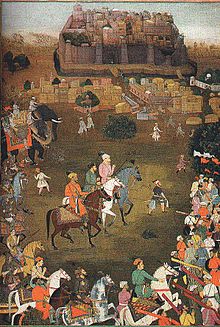Siege of Orchha (1635)
| Siege of Orchha | |||||||
|---|---|---|---|---|---|---|---|
| Part of Sieges of Mughal Empire | |||||||
 Capture of Orchha | |||||||
| |||||||
| Belligerents | |||||||
|
|
Rajputs | ||||||
| Commanders and leaders | |||||||
|
| Jhujhar Singh | ||||||
| Units involved | |||||||
|
Mughal Army |
Rajputs | ||||||
| Strength | |||||||
|
~20,000~ 1,000 Cavalry 1,000 Archers | ~Less than Mughal~ | ||||||
| Casualties and losses | |||||||
| Light | High | ||||||
The siege of Orchha was a military expedition of Mughal empire under Aurangzeb aganist rebellious Bundela Rajputs under Jhuhar Singh.[1][page needed]The Mughal army captured the Bundela capital during the combined siege of Orchha, on October 4, 1635. Aurangzeb raised the Mughal flag on the highest terrace of the Jahangir Mahal and installed Devi Singh as the new administrator, while Jhujhar Singh escaped.[2][page needed]
Background
During the rule of the Mughal emperor Jahangir, his vassal, Vir Singh Deo, was ruler of the Orchha area. His reign ended in either 1626 or 1627 and it was during this period that Orchha reached its zenith in both political power and architectural splendour. Examples of the architecture include the Jahangir Mahal (built ca. 1605) and the Sawan Bhadon Mahal.
In 1626, Jhujhar Singh succeeded his father Vir Singh Deo as ruler and determined not to remain a vassal of the Mughal Empire as his father had been. He attempted to assert independence from the reigning emperor, Shah Jahan.
In 1627 Jhujhar Singh, the son and successor of Orchha's Vir Singh Deo (r. 1605-27), proceeded to Agra to pay homage to Shah Jahan, who confirmed him with a rank of 4,000/4,000. But the next year, after the emperor ordered an inquiry into the unauthorized gains that Vir Singh Deo had made during Jahangir's regime, Jhujhar Singh became alarmed and, fled to Agra. Shah Jahan responded by sending an army that pursued his Rajput vassal to Erachh, the fort in Bundelkhand to which he had fled, sixty-five kilometres north-east of Jhansi. After a successful siege of the stronghold, the rebel Rajputs submitted and begged forgiveness for his misdeeds, which the emperor readily granted, restoring him to his original rank.[3][page needed]
In 1634 the Bundela raja reverted to his errant ways. Back in his ancestral capital of Orchha, Jhujhar Singh led an unprovoked attack on the fort of Chauragarh (one hundred kilometres west-south-west of Jabalpur), which belonged to the Gond chieftain Prem Narayan. This siege led to another instance of jauhar as Prem Narayan. In extreme desperation, he massacred his women and fought to the death with 300 kinsmen, after which Jhujhar Singh occupied the fort.[3][page needed]
The siege
Mughal Emperor Shah Jahan planned a campaign to strike the rebellious territory known as Bundelkhand and its capitol Orchha from 3 sides: Syed Khan-i-Jahan with 10,500 men from Badaun, Abdullah Khan Bahadur Firuz Jang with 6000 men from the north and Khan-i-Dauran with 6000 men from the south-west. The three generals were of equal rank and hence to ensure unity and co-operation amongst them, Aurangzeb, then a 16 year old commander of 10,000 men, escorted by 1000 archers and 1000 horses, was made the (nominal) commander-in-chief.[2][page needed]
The campaign was known for its spectacular usage of artillery according to Mughal accounts more than 220 cannons were used. Mughal armies of 32,000 men captured the Bundela capital during the combined siege of Orchha, on October 4, 1635.The Mughal army recovered treasures worth one crore which Jujhar Singh had hidden in various wells in Deogarh territory. After a flurry of events, the Gonds killed Jhujhar and his son in their sleep and sent their heads to the Mughal Emperor Shah Jahan in December 1635.[2]
Aftermath
The Mughal empire, indeed, would never find a constitutional solution to the problem of what measure of territorial power to grant to its zamindars. As the latter knew that they would only become attractive as imperial subjects to the degree they gathered strength as careful rebels, an ever-changing mix of bhumiyavat and negotiation would continue to be the most efficient method of registering the relative strength of all parties. Jujhar Singh's death did not render the Mughal-Bundela relation- ship any less problematic. Devi Singh, the head of the rival lineage of Chanderi, was a failure at Orchha. A young son of Jujhar and, later, one of his old associates by the name of Champat Rai Bundela, continued to champion the Orchha case, in the end compelling Shahjahan to restore a son of Vir Singh Deo to the gaddi. After this, Champat Rai would only for short periods serve the empire or at least desist from causing trouble.[4][page needed]
References
- ISBN 978-0-521-56603-2.
- ^ a b c Others, Muzaffar H. Syed & (2022-02-20). History of Indian Nation : Medieval India. K. K. Publications.
- ^ ISBN 978-0-14-196655-7.
- ISBN 978-0-521-52305-9.
